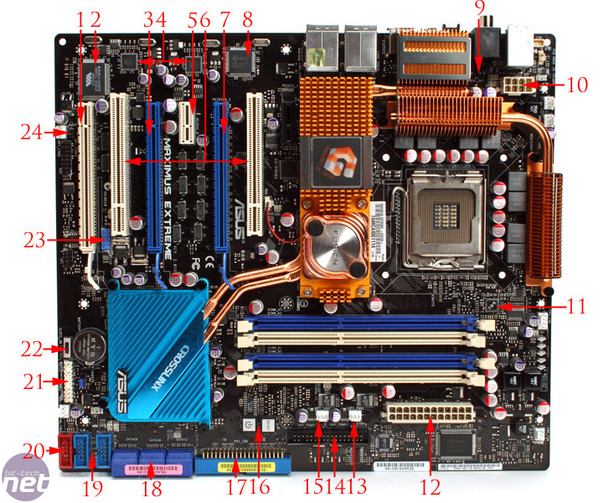Layout
The board feels massive. It may only be an inch wider than the Formula but it feels a whole lot more because the 24-pin ATX and floppy connectors are almost in the same place as they were on the Formula, rather than at the edges where we normally find them.Because of this it feels a bit of an "after-thought" board in comparison. It'll still fit in a normal ATX case without issue mind, unless you have something particularly small instead.
The board also looks better without the multi-coloured heatsink array strewn across it - take them off and everything fits within a simple black, white and blue theme. With them on and there's this mishmash of anodised blue aluminium and tons of copper fins.
PCI & PCI-Express
There are two legacy PCI slots but only one PCI-Express x1 slot, and that's thrown in directly below the primary PCI-Express x16 slot. Even though we've previously wanted more PCI than PCI-Express x1 slots, having at least one of each openly available should be a given. I suppose it depends on your use of dual height graphics cards and need for PCI versus PCI-Express x1, but more x1 cards are becoming available and if you've bought the Maximus buying an expensive, dual height card is almost a given.

The white PCI-Express x16 slot at the bottom could be used by an x1 card, but that would convert the second blue slot into a Gen-1.0 x8. You see, Asus uses the same digital PCI-Express switch it used on the Blitz to convert a single PCI-Express x16 lane into two x8s. This worked elegantly on the Blitz as it was the only P35 board with balanced x8/x8 CrossFire performance, however the splitter chipset only supports Gen-1.1 PCI-Express and the two x16 lanes from the northbridge are Gen-2.0.
This means when you use it, the bandwidth is not only halved from x16 to x8 but it's also halved again from Gen-2.0 to Gen-1.0. The three PCI-Express cards in the x16 slots become an x16 (2.0), x8 (1.1) and x8 (1.1) situation.
This seems all that's available though, and it's a better situation than MSI does with its X38 Diamond we previously looked at - here the data is split into an x16, x8, x4, x4 to squeeze four graphics slots on the board just to get the CrossFireX tick box. To its credit, Asus makes all the x16 slots dual height compatible (depending on how far the bottom of your case if from the bottom of your board) which makes sense, unlike MSI (and many AMD 790FX boards for that matter), which forces the use of (slower) single height cards.

MSI MPG Velox 100R Chassis Review
October 14 2021 | 15:04









Want to comment? Please log in.